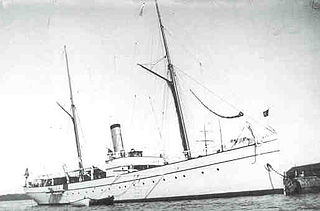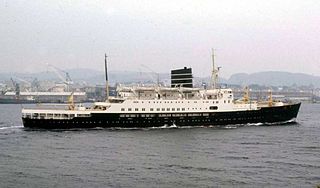
Haakon VII was King of Norway from November 1905 until his death in September 1957.
Hurtigruten, formally Kystruten Bergen-Kirkenes, is a Norwegian public coastal route transporting passengers that travel locally, regionally and between the ports of call, and also cargo between ports north of Tromsø.

The Norwegian campaign involved the attempt by Allied forces to defend northern Norway coupled with the resistance of the Norwegian military to the country's invasion by Nazi Germany in World War II.

HNoMY Norge is the Royal Yacht of the King of Norway. One of only three remaining Royal Yachts in Europe, the ship's name Norge is Norwegian Bokmål for Norway. The Royal Yacht Norge was the Norwegian people's gift to King Haakon VII in 1947. The yacht is owned by the King but maintained and crewed by the Royal Norwegian Navy. Originally built in 1937 in the United Kingdom for Thomas Sopwith, she served in the Royal Navy as an armed yacht during the Second World War.

HNoMS Heimdal was a Norwegian warship built at Akers mekaniske verksted in Kristiania, Norway in 1892 with build number 137.

HNoMS Honningsvåg was a naval trawler that served throughout the Second World War as a patrol boat in the Royal Norwegian Navy. She was launched at the North Sea harbour of Wesermünde in Hanover, Germany in February 1940 as the fishing trawler Malangen and was captured by Norwegian militiamen at the North Norwegian port of Honningsvåg during her maiden fishing journey to the Barents Sea. Having taken part in the defence of Norway in 1940 she spent the rest of the war years patrolling the ocean off Iceland. She was decommissioned in 1946, sold to a civilian fishing company in 1947 and scrapped in 1973.

SS Sanct Svithun was a 1,376 ton steel-hulled steamship built by the German shipyard Danziger Werft and delivered to the Norwegian Stavanger-based shipping company Det Stavangerske Dampskibsselskab on 1 July 1927. She sailed the Hurtigruten route along the coast of Norway until she was lost in an air attack on 30 September 1943 during the Second World War.
Robert Millar was an Irish born, Norwegian advertising executive and author. Each year the Trondheim Marketing Association awards the Robert Millar Prize in his honour.

SS Henry was a Norwegian steam-powered cargo ship best known for being one of the two ships sunk in one of the most controversial incidents in Norway during the Second World War.

SS Irma was a 1,322-ton steamship built by the British shipyard Sir Raylton Dixon & Co. Ltd. in Middlesbrough in the north-east of England. She was delivered to the Norwegian passenger ship company Det Bergenske Dampskibsselskab of Bergen in 1905. Irma sailed for the company until she was attacked and sunk by two MTBs belonging to the Royal Norwegian Navy on 13 February 1944.

SS Dronning Maud was a 1,489 ton steel-hulled steamship built in 1925 by the Norwegian shipyard Fredrikstad Mekaniske Verksted in Fredrikstad. Dronning Maud was ordered by the Trondheim-based company Det Nordenfjeldske Dampskipsselskap for the passenger and freight service Hurtigruten along the coast of Norway. She served this route as the company flagship until she was sunk under controversial circumstances during the 1940 Norwegian Campaign.

Richard Bernhard With was a Norwegian ship captain, businessman and politician for the Liberal Left Party. He is known as the founder of the shipping companies Vesteraalens Dampskibsselskab and Hurtigruten.

SS Barøy was a 424-ton steel-hulled steamship delivered from the Trondhjems mekaniske Værksted shipyard in Trondheim in 1929. She had been ordered by the Norwegian shipping company Ofotens Dampskibsselskab for the local route from the port city of Narvik to the smaller towns of Lødingen and Svolvær. After the company suffered ship losses in the 1940 Norwegian Campaign Barøy was put into Hurtigruten service on the Trondheim–Narvik route. She was sunk with heavy loss of life in a British air attack in the early hours of 13 September 1941.

The Bergen Steamship Company (BDS), was founded in 1851 by Michael Krohn to operate a shipping service between the Norwegian ports of Bergen, Stavanger, and Kristiansand and the German port of Hamburg with the paddle steamer Bergen. The company funnel was black with three widely spaced narrow white bands.
Haga was a 1,258 GRT cargo ship that was built in 1938 by Flensburger Schiffbau-Gesellschaft, Flensburg, Germany for German owners. She was seized by the Allies in May 1945, passed to the Ministry of War Transport (MoWT) and was renamed Empire Consumer. In 1946, she was transferred to the Norwegian Government and renamed Hauknes. She was sold into merchant service in 1947 and renamed Orm Jarl. In 1958, she was sold to Yugoslavia and renamed Travnik. A further sale in 1965 saw her renamed Komovi. In 1967, she was sold to Greece and renamed Moschoula. She served until 1968 when she was scrapped.
HNoMS Tor was a Sleipner-class destroyer of the Royal Norwegian Navy that was launched in September 1939. She was under outfitting and testing when Nazi Germany invaded Norway on 9 April 1940. Although scuttled by Norwegian naval personnel to prevent her from being captured by the invading forces, she was soon salvaged by the Germans and put into service with the Kriegsmarine. Under the name Tiger she served out the war as an escort and training vessel, being recovered by the Norwegians in Denmark after the German capitulation in 1945. After the war she was converted to a frigate and served until 1959.
Sophus Weidemann was a Norwegian engineer and industrialist who contributed to the development of the shipping industry in Norway.

SS Nordnorge was a Norwegian steamship built in 1923–24 by Trondhjems mekaniske Værksted, for the Narvik-based Norwegian shipping company Ofotens Dampskibsselskap. First employed on the company's Narvik-Trondheim route, she was transferred to the longer Hurtigruten route in late 1936. Seized by the Germans following their April 1940 attack on Norway, she was used as covert troop ship and was sunk shortly after delivering her cargo of German troops behind Allied lines on 10 May 1940.

SS Sirius was a Norwegian iron-hulled steamship built in Germany in 1885. Sirius spent over 55 years sailing with cargo, regular passengers and tourists between Norway and Europe, and on the Norwegian coast. In 1894-1895, she served a year on the Hurtigruten route on the coast of Norway, before reverting to her former duties.
Ole Siem was a Norwegian naval officer, businessman and politician.
















